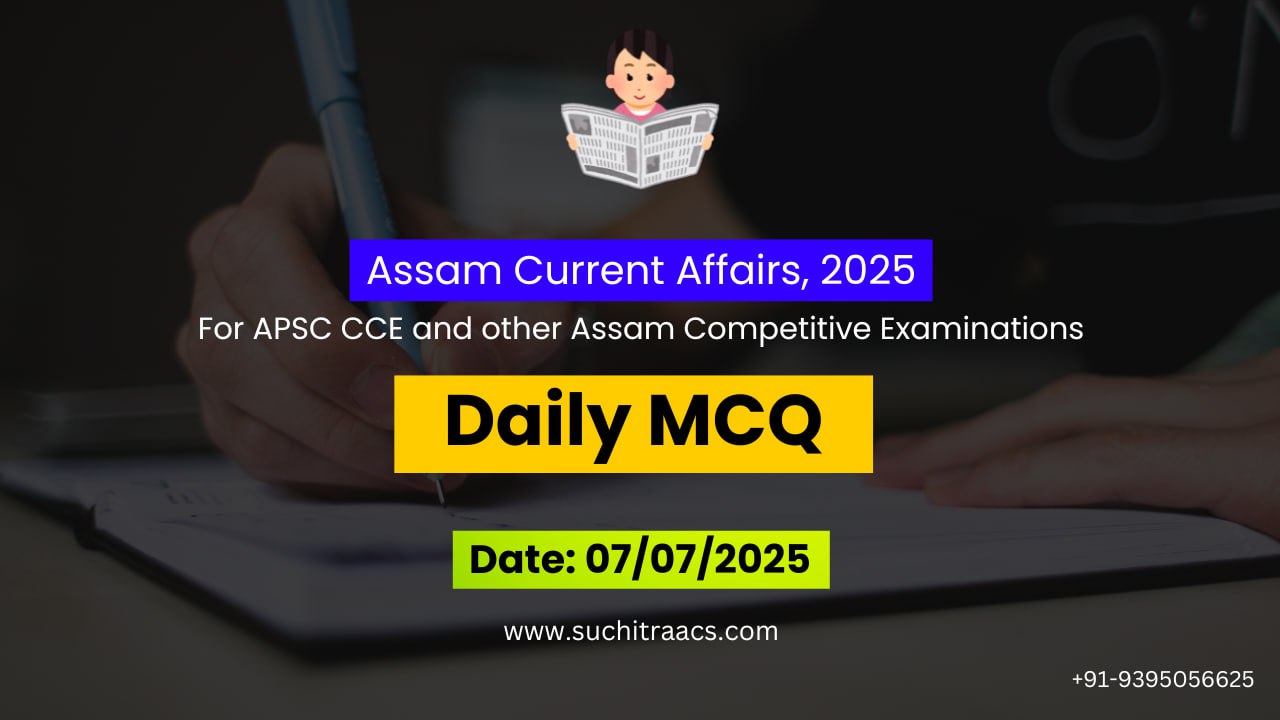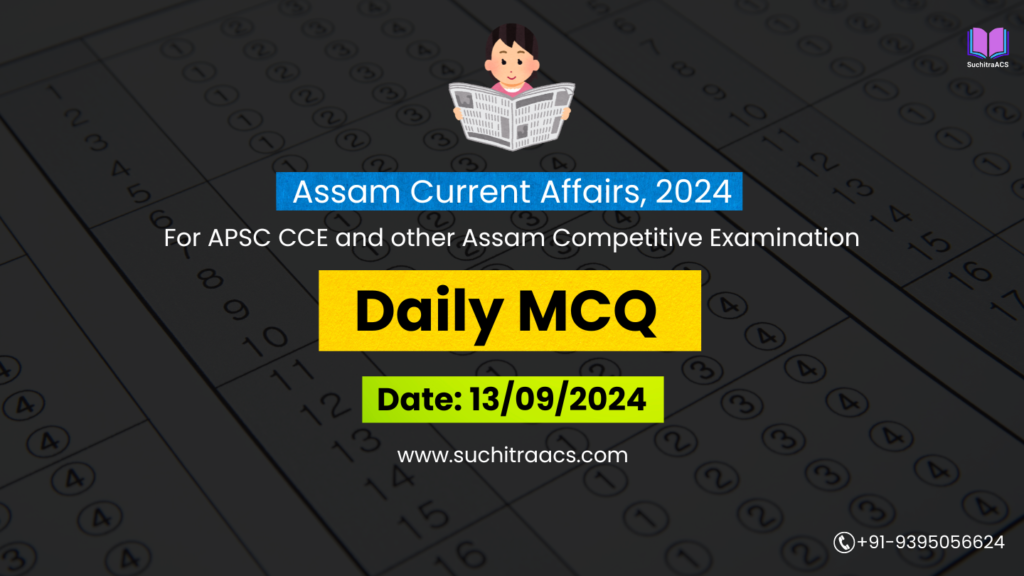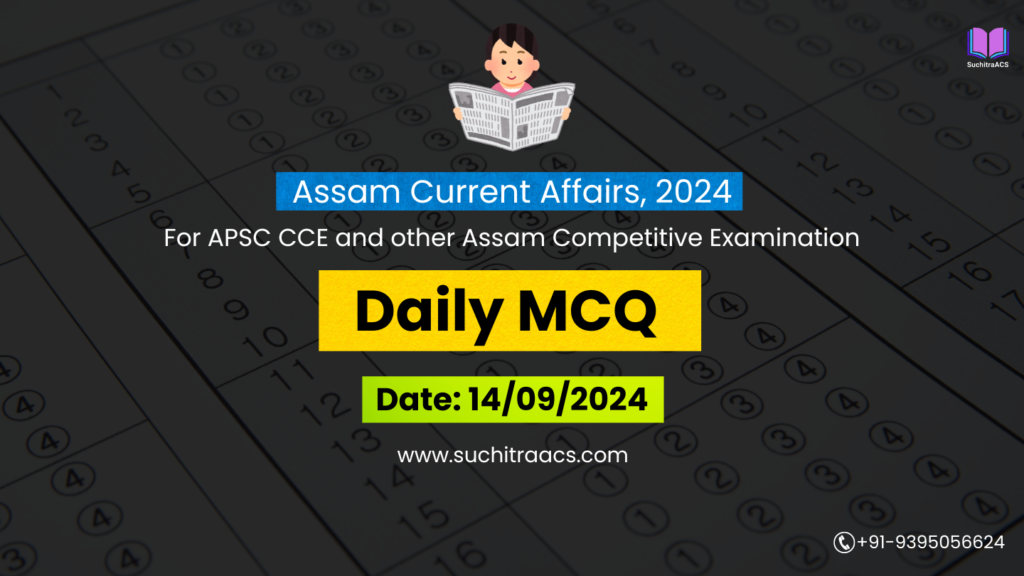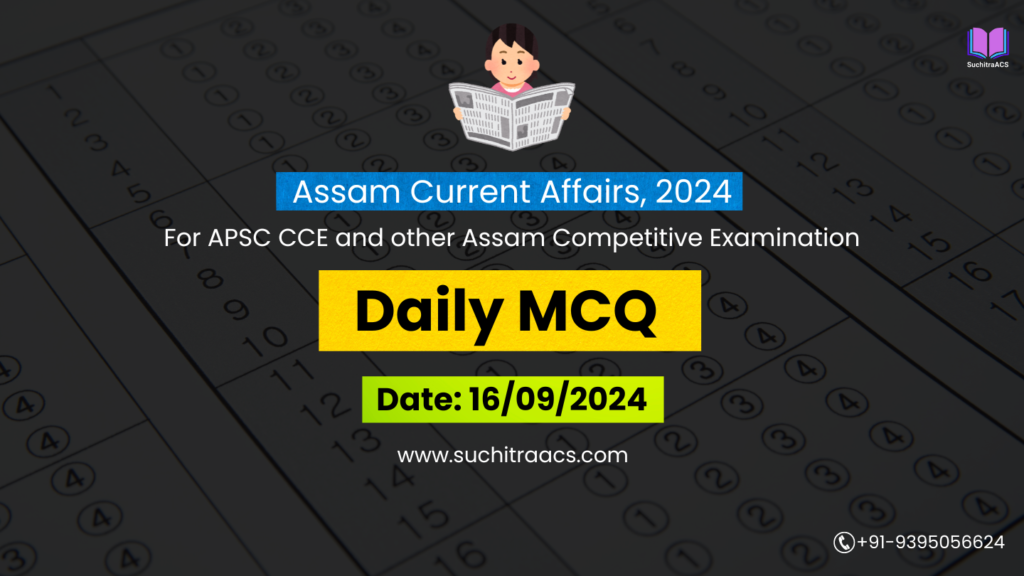APSC MCQs / APSC Prelims Practice Questions based on Assam Tribune (Daily) – 07/07/2025
For APSC CCE and other Assam Competitive examinations aspirants, practicing Daily MCQs is vital. This blog covers most important Prelims questions from the Assam Tribune today (07-07-2025). These issues are key for both APSC Prelims syllabus, offering insights into the important topics of current affairs.
✨ APSC CCE Online Coaching, 2026

APSC MCQs / APSC Prelims Practice Questions (Date: 07/07/2025)
🔹 TOPIC 1: Dehing Patkai National Park and Inter-State Border Conflict
Q1. Consider the following statements about Dehing Patkai National Park:
- It is located along the Assam-Nagaland border.
- It is the only tropical rainforest in Assam.
- It was notified as a national park in 2021.
Which of the statements given above is/are correct?
(a) 1 and 2 only
(b) 2 and 3 only
(c) 1 and 3 only
(d) 3 only
✅ Answer: (b)
📘 Explanation:
- Statement 1 is incorrect: Dehing Patkai is along the Assam–Arunachal Pradesh border, not Nagaland.
- Statement 2 is correct: It is Assam’s only tropical rainforest, often referred to as the “Amazon of the East.”
- Statement 3 is correct: It was declared a national park in 2021.
Q2. Which of the following is a major concern related to Dehing Patkai National Park recently reported in the news?
(a) Poaching of one-horned rhinoceros
(b) River pollution due to oil spills
(c) Inter-state encroachment from Arunachal Pradesh
(d) Forest fires due to shifting cultivation
✅ Answer: (c)
📘 Explanation:
Encroachment from Arunachal Pradesh into Assam’s notified Dehing Patkai National Park has raised administrative and ecological concerns.
🔹 TOPIC 2: NRC Leftouts and Statelessness
Q3. With reference to the NRC process in Assam, consider the following statements:
- NRC is a statutory register of Indian citizens compiled under the Citizenship Act, 1955.
- Foreigners Tribunals are empowered to declare a person stateless.
- NRC is being implemented in Assam as per the cut-off date of 24th March 1971.
Which of the statements is/are correct?
(a) 1 and 2 only
(b) 2 and 3 only
(c) 1 and 3 only
(d) 3 only
✅ Answer: (c)
📘 Explanation:
- Statement 1 is correct: NRC is linked to Section 14A of the Citizenship Act, 1955, though its implementation was court-monitored.
- Statement 2 is incorrect: Foreigners Tribunals can declare someone as a foreigner, but not stateless (no such legal provision in Indian law).
- Statement 3 is correct: As per the Assam Accord (1985), 24 March 1971 is the legal cut-off date.
Q4. The term “stateless person” as per the UN definition refers to:
(a) A person who has committed cross-border crimes
(b) A refugee who has applied for asylum but was denied
(c) A person not considered a national by any country under the operation of its law
(d) A person whose name is excluded from NRC
✅ Answer: (c)
📘 Explanation:
The 1954 UN Convention defines a stateless person as one “not considered as a national by any State under the operation of its law.” India is not a signatory to this convention.
🔹 TOPIC 3: NISAR and Flood Monitoring in Assam
Q5. The NASA-ISRO Synthetic Aperture Radar (NISAR) satellite is primarily used for:
(a) Monitoring air pollution in urban areas
(b) Assessing the strength of cyclones in deep sea
(c) Detecting changes in Earth’s surface, including glaciers and wetlands
(d) Providing GPS navigation to rural areas
✅ Answer: (c)
📘 Explanation:
NISAR uses dual-frequency radar to detect minute changes in Earth’s surface—including wetland shrinkage, flood spread, glacier movement, and forest loss.
Q6. Consider the following features of NISAR:
- It is jointly developed by ISRO and NASA.
- It operates only in the optical range of the electromagnetic spectrum.
- It provides high-resolution Earth images even through cloud cover.
Which of the statements is/are correct?
(a) 1 and 3 only
(b) 2 and 3 only
(c) 1 and 2 only
(d) 1, 2 and 3
✅ Answer: (a)
📘 Explanation:
- Statement 1 is correct: NISAR is a joint mission between NASA and ISRO.
- Statement 2 is incorrect: It uses Synthetic Aperture Radar (SAR), not optical.
- Statement 3 is correct: SAR can penetrate clouds and darkness, making it ideal for flood monitoring.
🔹 TOPIC 4: School Dropouts in Tea Garden Areas
Q7. Which of the following are reasons for high dropout rates among children in Assam’s tea garden communities?
- Lack of accessible schools and transport
- Household poverty and alcoholism
- Language barriers in early education
- Excessive focus on vocational training in early years
Select the correct answer:
(a) 1, 2 and 3 only
(b) 1, 2 and 4 only
(c) 2, 3 and 4 only
(d) 1, 2, 3 and 4
✅ Answer: (a)
📘 Explanation:
- 1, 2, and 3 are well-documented factors in dropout surveys.
- Statement 4 is incorrect: The problem is lack of quality schooling, not excessive vocational training.
Q8. Which of the following schemes specifically targets the welfare of children in tea tribe communities of Assam?
(a) PM Poshan Abhiyaan
(b) Samagra Shiksha
(c) Tea Tribes Development Mission
(d) PM Jan Vikas Karyakram
✅ Answer: (c)
📘 Explanation:
Tea Tribes Development Mission (TTDM) is a state-level initiative providing education, skill development, and healthcare specifically for the tea tribe population in Assam.
🔹 TOPIC 5: Cybercrime and Digital Fraud in Assam
Q9. Which of the following is/are functions of the Indian Cyber Crime Coordination Centre (I4C)?
- Coordination of cybercrime investigations across states
- Real-time freezing of bank accounts used in fraud
- Framing laws and punishments for cyber offenses
Select the correct answer:
(a) 1 and 2 only
(b) 2 and 3 only
(c) 1 and 3 only
(d) 1, 2 and 3
✅ Answer: (a)
📘 Explanation:
- I4C is a coordination platform by MHA.
- It helps states freeze suspect accounts via the Citizen Financial Cyber Fraud Reporting System (CFCFRS).
- Framing laws is not its function; that falls under the Legislature and Ministry of Law/IT.
Q10. Which of the following cyber laws in India deal with identity theft and online cheating?
- Section 66C of the IT Act, 2000
- Section 66D of the IT Act, 2000
- Section 420 of IPC
Select the correct answer:
(a) 1 and 2 only
(b) 2 and 3 only
(c) 1 and 3 only
(d) 1, 2 and 3
✅ Answer: (d)
📘 Explanation:
Section 420 IPC: Cheating and dishonestly inducing delivery of property
Section 66C: Identity theft
Section 66D: Cheating by impersonation using communication devices
✨ APSC CCE Courses, 2025-26 offered by SuchitraACS


🔔 Join Our WhatsApp Study Group!
For exclusive access to premium quality content, including study materials, current affairs, MCQs, and model answers for APSC CCE and other Assam competitive exams.
Click here to join: SuchitraACS Study WhatsApp Group
📚 Want to know more about SuchitraACS’s most affordable courses?
Click here to know more: SuchitraACS Courses for APSC CCE and Assam Competitive Examinations




